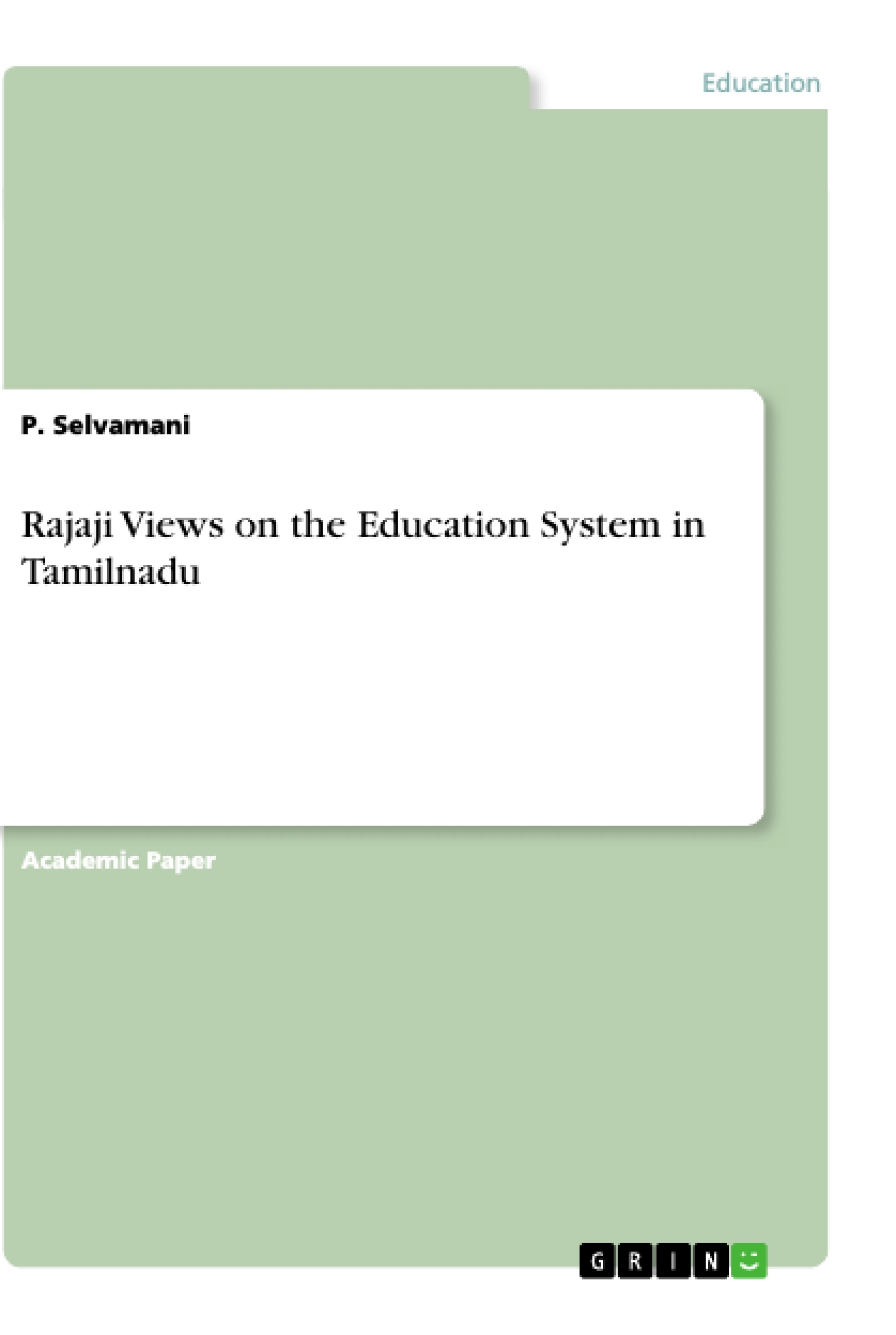This book is organized into six chapters. The first gives the theme of the study and mentions the reasons for choosing the scheme and also explains the objectives. The second chapter covers the socio-educational profile of Madras Presidency during and before the introduction of Kula Kalvi Thittam. It also focuses the attention to portray the social and communal politics of Madras Presidency.
The political life of Rajaji, his political experiences, visions and ideas of education are expressed in the third chapter. The fourth chapter acclaims the introduction of Kula Kalvi Thittam, its broad features and make-shift of historical sequence. It represent that this policy is neither the national interests, nor the masses. This educational policy is represented on the personal bias of Rajaji, backed by the ambitions of the members of the upper classes and the Brahmin interests.
The fifth chapter presents the critical view of the theorists, educationalists, politicians, writers and orators. It is also criticized because of its narrow-egoistic views. In the final chapter an attempt is made to summaries some of the concrete views of Kula Kalvi Thittam.
Table of Contents
- CHAPTER I: INTRODUCTION
- CHAPTER II: SOCIO- EDUCATIONAL BACKGROUND OF TAMIL NADU STATE
- The Emergence of a new society
- The Composition of the New Elite
- The Caste Structure in Madras Presidency
- The Brahmins
- The Formation of Caste Organization In Madras Presidency
- Influence of Justice Party on Dravidian Movement
- Justice Party Administration
- Education in the Justice Party
- Midday Meal Scheme
- The Revival of the Programme
- Madras Elementary Education Amendment Act
- The Emergence Of The Dravida Kazhagam and Its Views On Education
- CHAPTER III: RAJAJI AND HIS POLITICAL PROFESSION
- Rajaji's Second Ministry
- C.R. Administration of Madras Presidency
- Rajaji in National Movement
- Governor-General of Independent India
- Rajaji's Vision and Ideas of Education
- Gandhi's Views on Education
- Gandhi's fundamental views of basic education
- The Wardha scheme of Education
- Rajaji's Views on Education
- Chapter IV: INTRODUCTION OF RAJAJI EDUCATIONAL SYSTEM
- The Details of the Scheme
- The Mode of Introduction
- The Scheme Withdrawn
- The Alagappa Chettiar Committee Report
- Implementation of the suggestions of the report- a follow up action
- CHAPTER V: PROS AND CONS OF THE RAJAJI EDUCATION SYSTEM
- The Views of the Educationists
- Criticism of the Shift System
- Parulekar's Scheme
- Rajaji and Statham
- Legal or Juristic Criticism
- Reactions
- The Socialist Party Criticism
- The Ruling Congress
- In Defence of the Scheme
- Aftermath of Agitation
- The Battle over the Scheme
- The Kulakalvi Thittam and the Experts Committee
- The Trends after the formation of the Andhra State
Objectives and Key Themes
This book aims to provide a comprehensive analysis of C. Rajagopalachari’s (Rajaji) education system in Tamil Nadu, highlighting its implementation, strengths, weaknesses, and impact on the socio-educational landscape of the state.
- The socio-educational background of Tamil Nadu during the pre-independence era
- The political career and educational vision of Rajaji
- The introduction and implementation of Rajaji's educational system
- The pros and cons of the system, including both positive and critical perspectives
- The long-term impact of Rajaji's educational reforms on the Tamil Nadu education system.
Chapter Summaries
- Chapter I: Introduction: This chapter sets the stage for the book, providing a brief overview of the topic and outlining the key themes to be explored.
- Chapter II: Socio- Educational Background of Tamil Nadu State: This chapter delves into the socio-educational context of Tamil Nadu in the lead up to the introduction of Rajaji's system. It examines the impact of caste structures, the rise of the Dravidian movement, and the education policies of the Justice Party.
- Chapter III: Rajaji and His Political Profession: This chapter focuses on the political career of Rajaji, exploring his involvement in the Indian national movement and his vision for education, drawing parallels with Mahatma Gandhi's educational philosophy.
- Chapter IV: Introduction of Rajaji Educational System: This chapter examines the introduction of Rajaji’s education system, including its details, mode of implementation, and eventual withdrawal.
- Chapter V: Pros and Cons of the Rajaji Education System: This chapter explores the various perspectives on Rajaji's educational system, including opinions from educationists, critics, and proponents.
Keywords
This book focuses on the education system introduced by C. Rajagopalachari (Rajaji) in Tamil Nadu, exploring its historical context, implementation, and impact. Key themes include: Rajaji's education system, Tamil Nadu, education reform, socio-educational background, Dravidian movement, Justice Party, Gandhian philosophy, and education policy.
- Quote paper
- Dr. P. Selvamani (Author), 2019, Rajaji Views on the Education System in Tamilnadu, Munich, GRIN Verlag, https://www.grin.com/document/468239




